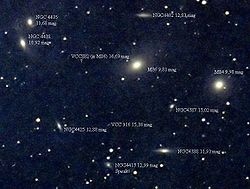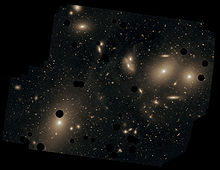- Virgo Cluster
-
Virgo Cluster 
Observation data (Epoch J2000) Constellation(s) Virgo & Coma Berenices Right ascension 12h 27m[1] Declination +12° 43′[1] Number of galaxies ~1500[1] Brightest member Messier 87 See also: Galaxy groups and clusters, List of galaxy clusters The Virgo Cluster is a cluster of galaxies whose center is 53.8 ± 0.3 Mly (16.5 ± 0.1 Mpc)[2] away in the constellation Virgo. Comprising approximately 1300 (and possibly up to 2000) member galaxies,[3] the cluster forms the heart of the larger Local Supercluster, of which the Local Group is an outlying member. It is estimated that its mass is 1.2×1015 M☉ out to 8 degrees of the cluster's center or a radius of about 2.2 Mpc.[4]
Many of the brighter galaxies in this cluster, including the giant elliptical galaxy Messier 87, were discovered in the late 1770s and early 1780s and subsequently included in Charles Messier's catalogue of non-cometary fuzzy objects. Described by Messier as nebulae without stars, their true nature was not recognized until the 1920s.[5]
The cluster subtends a maximum arc of approximately 8 degrees centered in the constellation Virgo. Many of the member galaxies of the cluster are visible with a small telescope.
The cluster is a fairly heterogeneous mixture of spirals and ellipticals.[6]As of 2004[update], it is believed that the spirals of the cluster are distributed in an oblong prolate filament, approximately 4 times as long as wide, stretching along the line of sight from the Milky Way.[7] The elliptical galaxies are more centrally concentrated than the spiral galaxies.
The cluster is an aggregrate of at least three separate subclumps centered on the galaxies M87, M86, and M49. Of the three subclumps, the one centered on M87 is the dominant one, with a mass of approximately 1014 solar masses, which is approximately an order of magnitude larger than the other two subclumps.[8]
The large mass of the cluster is indicated by the high peculiar velocities of many of its galaxies, sometimes as high as 1,600 km/s with respect to the cluster's center.
The Virgo cluster lies within the Local Supercluster, and its gravitational effects slow down the nearby galaxies. The large mass of the cluster has the effect of slowing down the recession of the Local Group from the cluster by approximately ten percent.
See also
- Coma Cluster, another large, nearby cluster of galaxies
- Fornax Cluster, a smaller nearby cluster of galaxies
References
- ^ a b c "NASA/IPAC Extragalactic Database". Results for Virgo Cluster. http://nedwww.ipac.caltech.edu/. Retrieved 2006-10-19.
- ^ Mei, Simona; Blakeslee, John P.; Côté, Patrick; Tonry, John L.; West, Michael J.; Ferrarese, Laura; Jordán, Andrés; Peng, Eric W.; Anthony, André; Merritt, Davi (2007). "The ACS Virgo Cluster Survey. XIII. SBF Distance Catalog and the Three-dimensional Structure of the Virgo Cluster". The Astrophysical Journal 655 (1): 144–162. arXiv:astro-ph/0702510. Bibcode 2007ApJ...655..144M. doi:10.1086/509598.
- ^ See Virgo Cluster.
- ^ Fouqué, P.; Solanes, J. M.; Sanchis, T.; Balkowski, C. (2001). "Structure, mass and distance of the Virgo cluster from a Tolman-Bondi model". Astronomy and Astrophysics 375 (3): 770–780. arXiv:astro-ph/0106261. Bibcode 2001A&A...375..770F. doi:10.1051/0004-6361:20010833.
- ^ Following the entry for M91 in the Connoissance des Temps for 1784, Messier added the following note:
- The constellation of Virgo, & especially the northern Wing is one of the constellations which encloses the most Nebulae: this Catalog contains thirteen which have been determined: viz. Nos. 49, 58, 59, 60, 61, 84, 85, 86, 87, 88, 89, 90, & 91. All these nebulae appear to be without stars: one can see them only in a very good sky, & near their meridian passage. Most of these nebulae have been pointed to me by Mr. Méchain. (see M91.)
- ^ Côté, Patrick; Blakeslee, John P.; Ferrarese, Laura; Jordán, Andrés; Mei, Simona; Merritt, David; Milosavljević, Miloš; Peng, Eric W. et al. (07 2004). "The ACS Virgo Cluster Survey". The Astrophysical Journal 153 (1): 223–242. arXiv:astro-ph/0404138. Bibcode 2004ApJS..153..223C. doi:10.1086/421490
- ^ M. Fukugita, S. Okamura, N. Yasuda (1993). "Spatial distribution of spiral galaxies in the Virgo Cluster from the Tully-Fisher relation". Astrophysical Journal 412: L13–L16. Bibcode 1993ApJ...412L..13F. doi:10.1086/186928.
- ^ The Virgo Super Cluster: home of M87 (with frames)
External links
Categories:- Galaxy clusters
- Virgo Cluster
- Virgo Supercluster
- Virgo constellation
- Coma Berenices constellation
Wikimedia Foundation. 2010.

